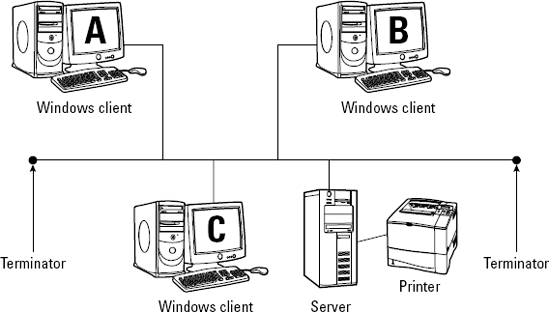1.2. Understanding Network Topologies
When building a network, be cognizant of some upfront decisions regarding the overall network setup. Building a network is like building a database: You have to understand the theory before you start the hands-on work.
Topology refers in a general sense to layout; similarly, a network topology defines the layout of the network. The three basic network topologies are bus, star, and ring. The following sections discuss the different network topologies and their characteristics.
1.2.1. Bus
A bus topology uses a main wire (or trunk) to connect all network devices so that they can communicate with one another. The main trunk is fairly cheap to install but expensive to maintain. Figure 1-3 shows a diagram of a bus topology; notice that all systems are connected to a main cable.
Figure 1.3. A bus topology.

When a workstation sends data to another workstation in a bus topology, data (in the form of an electrical signal) is delivered across the full length of the trunk. Each workstation looks at all data that runs along the trunk. If the data is destined for a particular workstation, that workstation copies the data to the memory on its network adapter.
For example, Figure 1-3 shows what happens when client A sends information to client B.
The information runs along the trunk.
When it passes by client C, client C checks whether it is also a destination ...
Get CompTIA A+® Certification All-In-One For Dummies®, 2nd Edition now with the O’Reilly learning platform.
O’Reilly members experience books, live events, courses curated by job role, and more from O’Reilly and nearly 200 top publishers.

